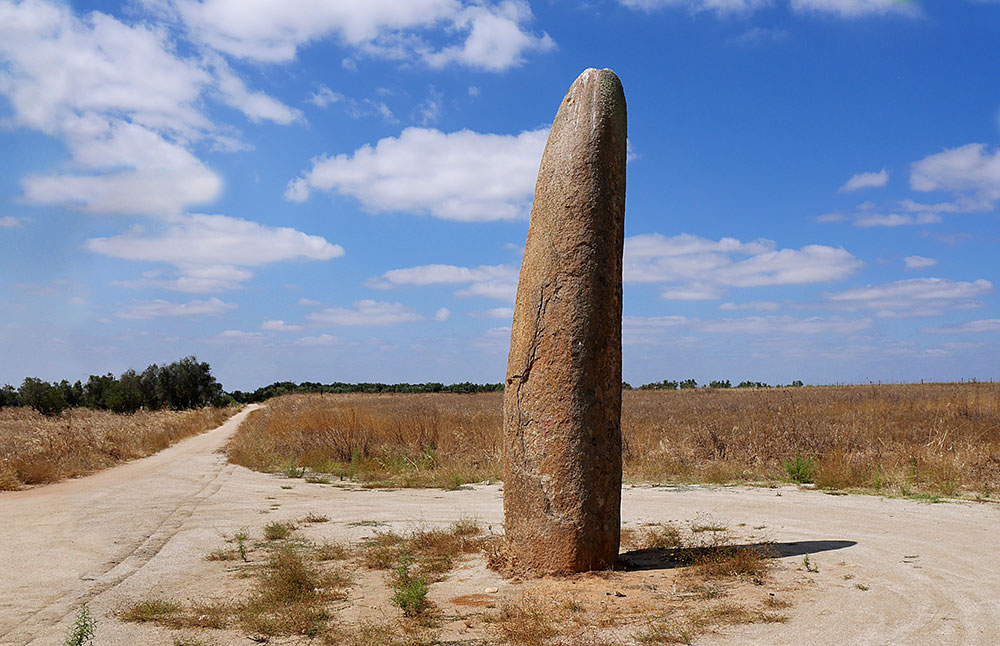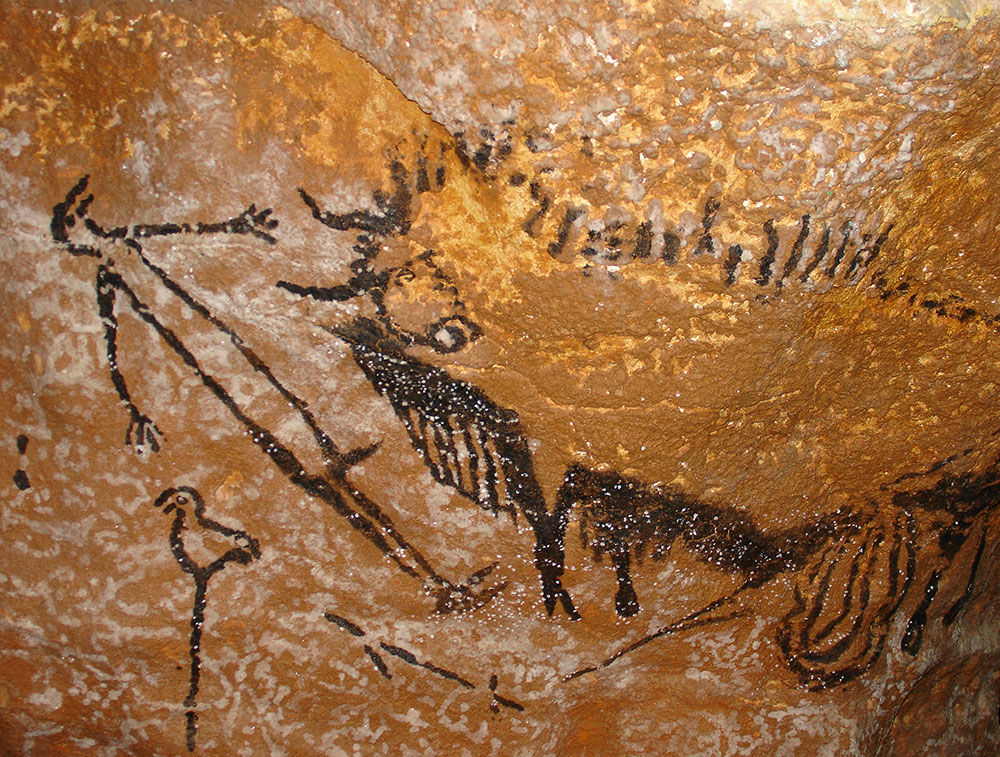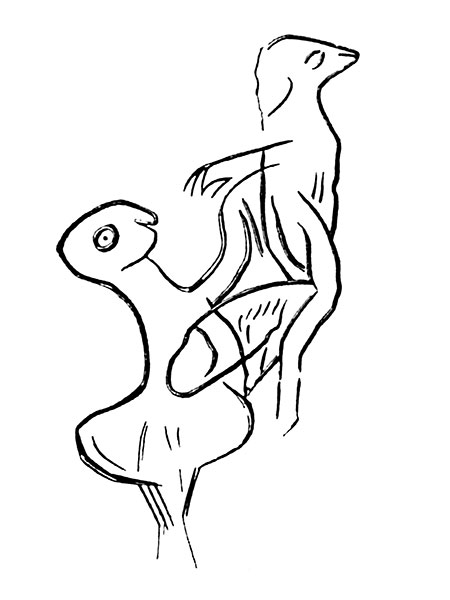Paleolithic legacy: From genital decoration to penile mutilation
Although human depictions are, generally speaking, seldom seen in prehistory (before written language), female genital representations are relatively common motifs in prehistoric times all over the world, often preserved on cave walls and rock shelters.
Not often seen or depicted, male genitals were also represented on cave wall art, both as isolated forms or as complete human male images, commonly known as ithyphallics. Moreover, female and male genitalia were sculptured on pieces obtained from excavations of archeological sites. These vulvar or phallic portable elements were etched (or carved) in stone, bone or antler. It should also be noted that humans and their genitals were also sometimes depicted as fine carvings in the decoration of bone fragments and small stones.
The most antique representations in prehistory date from the Upper Paleolithic (approximately 40,000- 12,000 years B.P. [before present]) and were found in Western Europe, especially Iberia and France.
However, wall art is a phenomenon present all over the world and both human figures and genital motives can be seen in every continent.
Classically, anthropologists and Paleolithic art experts have related the erectile status depicted in prehistoric art to rituals of fertility, possibly influenced by male deities in Levant Neolithic (9,000-6,000 years B.P.) and also by Chalcolithic Atlantic culture (6,000-4,000 years B.P.) that transformed the landscape building megalithic tombs and setting menhirs with phallic shape in many places in Europe (Figure 1). In those late prehistoric times humans have ceased being hunter gatherers and settled in a territory. Their future depended on the fertility of the land, crops and animals. However, in more ancient times, during the Paleolithic period, the meaning of penile representations was much richer and more diverse.

Figure 1: Outeiro menhir with phallic shape (Regengos de Monsaraz, Portugal).
Penis: An optic clue
A Paleolithic penis can be represented as part of a human or animal form and also as an isolated figure by itself. The size of the phallic representation seems an important issue. It is true that the phallus sometimes appears more important than the human form and is the optic clue that determines the representation as an outstanding part of the whole. However, the size of the penis is not always that exaggerated and sometimes the penis is represented but almost hidden to the eyes of the observer or timidly suggested.
Human and animal erection captivated the artist’s minds and possibly implied virility and strength, not opposed to the feminine but to nature itself. Man or animal against nature or even better defined, the individual and its seeding or reproductive capacity against an adverse natural world, of which, paradoxically, the individual is also part of.
Many ithyphallic men share animal and human characteristics; that is, they mixed details of different animal species, according to what has been called anthropomorphic thinking which was characteristic of the Paleolithic mind. They are usually represented alone, not as part of a scene in very noticeable places in caves, and often referred to as sorcerers although there is no evidence of religious feeling behind these representations.
In rarer examples these ithyphallics were a part of a composition of figures. In several of these, male erection is associated with serious danger or death. Erection could mean virility and strength, not fertility as in Neolithics, and I dare say not opposed to the feminine but to nature and the animal world. The link between erection and dangerous situations has been interpreted as a representation of the transition to death, possibly a shamanistic interpretation of the physiologic phenomenon of male orgasm linked to the loss of the soul.
Among others we have some beautiful examples of this dreadful association in the Lascaux cave where a hunter lies dead on the ground in front of an eviscerated bison (Montignac, France) (Figure 2) or in the Addaura cave (Palermo, Sicily) where a group of men are about to be suffocated and surrounded by a group of executor dancers.

Figure 2: The erect hunted hunter in Lascaux lies dead on the ground near an eviscerated bison (Montignac, France).
Sometimes males and male genitals are represented close to females or female genitals, and these representations recall mating rituals. Even coital scenes are also depicted. These representations are more frequent between animals than humans.
Possibly the oldest human intercourse were represented in Los Casares cave (Guadalajara, Spain) (Figure 3) and in a stone block detached from the Laussel shelter (Dordogne, France) (Gravettian- Solutrean, around 20,000 years B.P.).

Figure 3: Possibly the oldest coital scene represented in the Los Casares cave (Guadalajara, Spain).
Other coital scenes which are absolutely naturalistic and, sexually speaking, diverse were represented in some stone blocks in the La Marche cave (Vienne, France) and in Enlène cave (Midi-Pyrénées, France) (Magdalenian, around 12,000 years B.P.). In some blocks from La Marche several scenes represent sex, but definitely not leading to reproduction. Also in Ribeira do Piscos (Foz Coa, Portugal) are thousands of Paleolithic representations which were produced in the open air on river banks and tributaries to the Douro river, also at Magdalenian time, where an ejaculating large size human figure was depicted with a prominent penis and its emission carved on a vertical rock. His mouth is open, with rays shining out or irradiating from his head, representing orgasm. In another very curious carving in open air at the Coa Valley, rear penetration with a condom was represented! However, it must be noted that this image is post-Paleolithic.
Ritualistic phallic forms Many portable art elements are batons on antler or bone and have the form and size of the penis. A collection of such instruments with phallic forms done with antler, bone, or stone have been recovered in the context of habitation from different excavations, most of them in France (Figure 4). All over Europe, other bone instruments of unknown use with prominent phallic decorations have also been found. This material was far from being waste itself, because it could have been used to make valuable spear points or pendants instead. Some believe they constitute dildos or domestic masturbating devices, but they could also have been used in rituals. The real meanings of these devices are totally unknown, but indicate that erection was important enough in these people’s minds to merit a depiction and preservation.

Figure 4: Paleolithic phallic instruments recovered from different excavations in France
These pieces show evidence of a culture that favored prepuce retraction. If Upper Paleolithic humans would have practiced circumcision, that would explain the scarcity of phallic representations that show phimosis. Also from a technical point of view, lithics had been developed to achieve clean cutting, and knowledge of the curative properties of ointments and creams made of natural elements could have facilitated the development of curative medical knowledge as well. Of course not all Paleolithic penises appear circumcised. On cave walls sometimes phimosis is evident in the depictions of some ithyphallics with sharpened or point-ending erectile phalluses (Murat, Gabillou, Tuc d’Audoubert, Les Trois-Frères, Les Combarelles, and as mentioned previously, in Lascaux and Addaura) an there is also an example with para-phimosis (Fronsac).
However, the majority of Paleolithic penises on portable art do not show phimosis. One of the batons recovered from Roc-de- Marcamps (Gironde, France) displays concentric lines on the preputial skin that covers the gland, possibly signaling the mark where to cut if circumcision was to be performed. Curiously, this is one of two portable art phalli represented with phimosis. The other example recovered in Fourneau-du-Diable (Dordogne, France) reveals partial preputial skin retraction However, we cannot ascertain that Paleolithic people practiced circumcision, but these observations favor a general culture of penile foreskin retraction, genital hygiene care and very likely the practice of circumcision. Although no specific ritual of circumcision has been represented in Paleolithic art, these data provide indirect evidence of its practice; possibly for decorative purpose or as a body mark, it may also have become fashionable.
Body decoration
There is archeological evidence that modern humans, and even Neanderthals, performed rituals of body decoration. Colors have been used as skin paint and make-up and hair dying were also applied. It should therefore not be surprising that some types of permanent corporal decorations may also have been performed. In fact, engravings with human representations and statuettes also provide evidence that body scars were considered aesthetical throughout the Upper Paleolithic.
Phallic decoration with a series of dots and lines is explicitly represented in European Palaeolithic art for identification or ornamental purposes. Scars, holes and marks appear intentionally and were made on the surface of the penis. Therefore, circumcision, male genital tattooing, piercing and scarification may have been decorative surgeries practiced during Paleolithic times. Most of the archaeological evidences of decorated phalli are Magdalenian elements that were recovered in France, but these designs could have been performed several thousand years earlier in Eastern Europe. It is therefore impossible to state the real origins of these peculiar prehistoric decorative rituals, but they could have taken place during a long time span between 38,000 to 11,000 years B.P.
Among those prehistoric rituals of prepuce retraction, circumcision, sub-incision, dorsal cutting, piercing, tattooing and scarification, only circumcision has continued, possibly because this practice is not only fashionable but also useful. Other practices, the intention of which was also to segregate individuals from the collective and to a specific marked group, have outlived very occasionally and remain purely anecdotal and decorative, and mainly among marginal individuals.
The same happens in modern primitives today; the roots behind body decoration were most probably spiritual, such as animist superstitions, based on a belief that ink and body art can protect the body from evil. Possibly, prehistoric tattooing and other forms of body decoration may have followed similar patterns of behavior.
Genital decoration
Otzi, the Neolithic man recovered from ice in the Alps gives definite proof that body tattoo was practiced in the final phases of European prehistory. Also during the metal ages, there is evidence of genital decoration in the warriors struggling in Vermelhosa (Foz Coa, Portugal) represented in a fine open air carving and also in the human representation in a stela from Badajoz (Spain) in the late Bronze age (3,200-2,700 years B.P.). These late prehistoric images represent penile infibulation, a form of penile mutilation that prevented warriors from losing their energy in penetration. This is another intervention in the penis, consisting of the insertion of a fibula that closes the preputial skin and interrupts male erection and intercourse. This same procedure has been performed in some modern primitive beings in Asia, Africa and America.
In conclusion, the representation of the penis throughout the different phases of prehistory is amazingly varied and rich. Far from being a nasty graffiti, the depiction of the phallus has captivated prehistoric artists and is a very important graphical motif that gives us many indirect clues on how our antecessors behaved and thought.
Author:
Javier Angulo, Professor of Urology Universidad Europea de Madrid
Laureate Universities Hospital Universitario de Getafe, Madrid (ES)
Every few years, the EAU History Office prepares a full-day Congress on the History of Urology. In 2016, this meeting will be held on Friday March 11th, in conjunction with the Annual EAU Congress in Munich. A day about the roots of urology. The lecture ‘The prehistoric penis’ is part of this congres.
See the full programme here.

